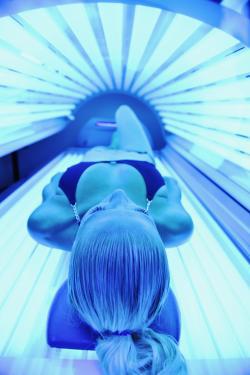A CDC report out this month found that nearly one in three white women aged 18 to 25 had used a tanning booth in the previous year. White women aged 18 to 21 went the most often, averaging 27.6 sessions per year—that’s over two sessions per month—while nearly 70 percent said they had gone at least 10 times in the last year.
Meanwhile, rates of melanoma, the most deadly form of skin cancer, have been increasing more quickly among young white women than their white male counterparts, which, in the words of the report, “might be attributable, in part, to their increased rates of indoor tanning.”
Skin cancer is now the most common form of cancer among young women. And frequent indoor tanners are up to three times more likely to develop melanoma than those who never go, according to a 2010 study.
Why are so many young white women willing to risk cancer to be tan?
One reason might be that they are more concerned about their current looks than the nebulous threat of cancer. A study suggests that they tend to be more put off by UV-induced wrinkles than melanoma. A government investigative report released in February puts out another theory: Because the $5-billion-a-year tanning industry downplays the health risks, extols the supposed benefits of tanning (like clearing acne and helping with depression), and targets women with age-specific advertising. Think prom specials and “unlimited tanning” student deals.
The industry also plays the victim. A popular industry website offers this gem of rationality: “Saying sunlight is harmful and therefore we should avoid it is as misleading as saying that water causes drowning, and therefore we should avoid it.”
It doesn’t help that tanning booths have been categorized with the least regulated medical devices—the FDA puts them with tongue depressors and Band-Aids, according to the report. Until this changes, tanning salons can assert that tanning beds would be more heavily regulated if they really were so dangerous.
While at least 33 states regulate tanning bed use for minors, California and Vermont are alone in banning them for those under 18. (New York and New Jersey, meanwhile, appear to be heading in that direction.)
Perhaps then, it is time to treat tanning like tobacco. Tanning salons could be required to display grotesque images of people who have gotten skin cancer, like warnings on cigarette packets. We could increase taxes on tanning salons, as is now de rigueur under the Affordable Care Act, considering it could offset what the CDC estimates as $1.7 billion per year to treat skin cancer and $3.8 billion in annual lost productivity. The higher prices might also dissuade returning customers. And as we do with cigarettes, this ban needs to be implemented across the nation for minors, coupled with a better effort at education.
But we also need to rethink our conception of female beauty, which until the 20th century generally abhorred the tan complexion. Ever since Coco Chanel, fresh from a trip to the French Riviera, famously decreed that “The 1929 girl must be tanned,” the association of tan skin with health and chicness has remained. (Meanwhile in Asia, women are, rather sadly, yearning for fairer complexions, as my colleague Ankita Rao notes). But if we still need a reminder of how ridiculous and truly unhealthy the quest for a trendy glow really is, look no further than Patricia Krentcil, the infamous “tanning mom.”
